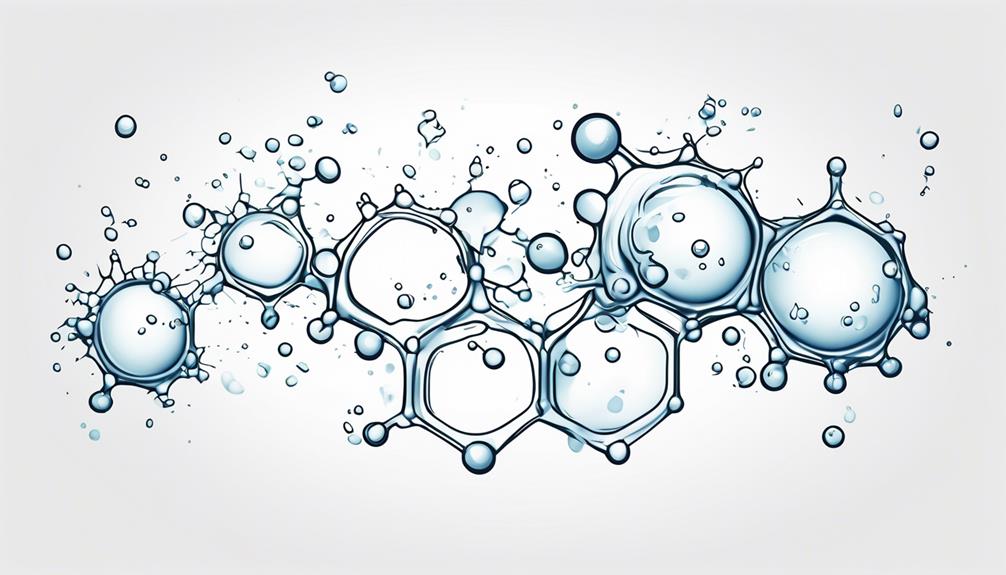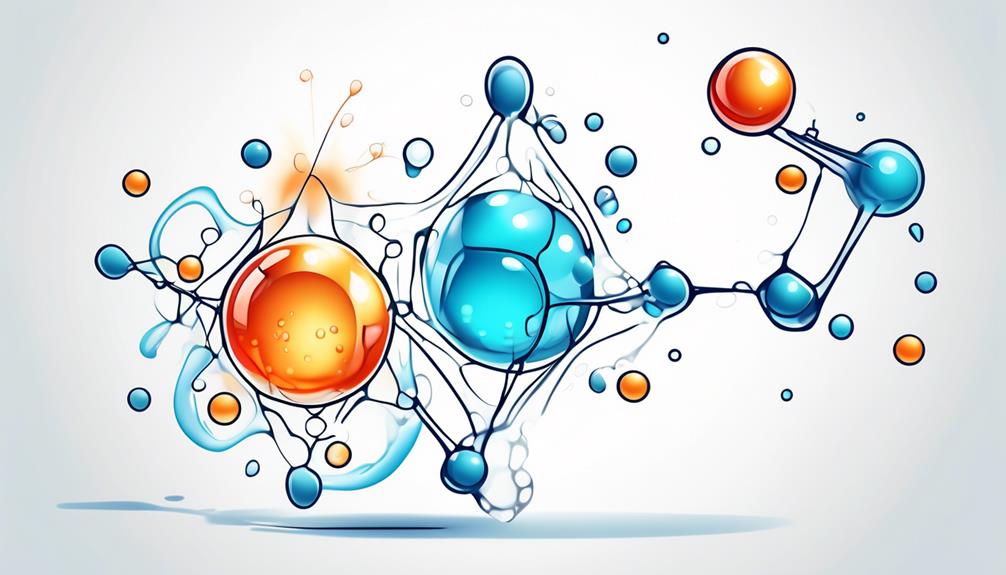Imagine water as a multifaceted gem, each facet revealing a different shimmering property waiting to be explored. As you dip your toes into the vast ocean of chemical explanations behind water's unique characteristics, you'll uncover the secrets behind its high boiling and freezing points, its ability to exist in various states simultaneously, and its role as the universal solvent.
But what lies beneath these surface explanations, and how do they shape the world around us in unexpected ways? Prepare to journey deeper into the molecular realm of water's mysteries, where each discovery unveils a new layer of understanding that may just leave you in awe of this seemingly ordinary yet extraordinary substance.
Key Takeaways
- Water's high surface tension is a result of the interplay of hydrogen bonds, impacting various natural and industrial processes.
- The polar nature of water enables the formation of hydrogen bonds, which become stronger as temperature decreases, influencing water's behavior in different states.
- Ice's unique property of expanding by 9% and floating on liquid water is crucial for ecosystem stability and plays a significant role in supporting habitats.
- Understanding water's chemical composition and bonding, particularly its role as a universal solvent, is essential for practical applications across scientific disciplines and industrial processes.
Boiling Point and Freezing Point
Water's boiling point of 100C, driven by its hydrogen bonds, plays a crucial role in various natural processes. This high boiling point is unusually high for a molecule of its size, making water unique. The ability of water to exist as a liquid at temperatures conducive to life is due to its high boiling point.
Conversely, its freezing point of 0C allows for ice to form, which is vital for ecosystem stability. These properties are a result of water's polar covalent bonds and hydrogen bonds, creating a dense and structured arrangement.
The high heat capacity of water is also tied to its boiling and freezing points, as it requires significant energy to change its state. This interplay of hydrogen bonds and polar covalent nature gives water its high surface tension, making it stand out as the liquid with the highest surface tension.
These properties are all interconnected, showcasing the intricate chemistry behind water's behavior.
Solid State (Ice)
Upon freezing, ice's hexagonal structure causes it to expand by 9% and float on liquid water, impacting ecosystems and human activities. The distinct states of ice reveal its unique characteristics:
- Less Dense: The density of ice is lower than that of liquid water due to its hexagonal structure and hydrogen bonds, allowing it to float.
- Environmental Impact: Ice's ability to float is crucial for aquatic life as it insulates the water below, providing a habitat for organisms during cold seasons.
- Human Utility: Ice's expansion upon freezing helps stabilize soil and rock formations, preventing damage from frost wedging, and is vital for recreational activities like ice skating and hockey.
Understanding the structure of ice and its behavior at different temperatures elucidates its importance in maintaining ecological balance and supporting various human endeavors. Ice's unique properties, from its expansion to its ability to float, play a critical role in shaping our environment and daily experiences.
Liquid State (Liquid Water)
Alright, let's talk about liquid water!
Imagine a vast body of water shimmering under the sun. The unique molecular structure of water gives it high surface tension, creating a thin 'skin' on its surface.
This property allows water striders to glide effortlessly on ponds and droplets to form perfect spheres.
Unique Molecular Structure
With a mesmerizing dance of molecules, liquid water showcases its extraordinary traits through a delicate balance of hydrogen bonds and polarity. The unique molecular structure of water gives rise to its exceptional properties:
- High Boiling Point Temperature: Due to the presence of hydrogen bonding between water molecules, liquid water exhibits a higher boiling point compared to other substances, making it essential for various biological processes.
- Less Dense Ice: The arrangement of molecules in ice is less compact compared to liquid water, causing it to be less dense. This unique property allows ice to float on water, preserving aquatic life in cold environments.
- Bond Angle and Hydrogen Atoms: Water molecules have a bent shape due to the repulsion between lone pairs of electrons on oxygen. This bent structure results in the formation of hydrogen bonds with neighboring molecules, contributing to the cohesive nature of water.
High Surface Tension
Intriguingly, as you explore the remarkable properties of liquid water, the high surface tension emerges as a captivating consequence of the strong intermolecular forces at play. Water's high surface tension, the result of hydrogen bonding between its polar molecules, is unmatched by other liquids.
This unique property allows water to bead up on surfaces and resist external forces. Due to its high surface tension, water can form droplets, exhibit capillary action, and support small insects like water striders. The cohesive forces between water molecules create a 'skin' on the surface, enabling objects to float or sink.
Understanding the role of hydrogen bonds in water's structure sheds light on its exceptional heat capacity, boiling temperature, and the formation of ice with a less dense structure.
Gas State (Steam)
When water transitions into a gas state, known as steam, its hydrogen bonds break, leading to unique properties that play crucial roles in various industrial applications. Here are some key points to understand about the gas state of water:
- Hydrogen Bond Breakage: In steam, the hydrogen bonds between water molecules are broken, allowing the particles to move further apart compared to the liquid state.
- Heat Energy Release: Steam causes more severe burns than liquid water because of the significant energy release when it condenses back into liquid form.
- Industrial Applications: Steam is utilized as a source of energy in various industrial and power generation processes. Its unique properties make it essential for operating turbines used in electricity generation.
Understanding the behavior of water when it transitions into a gas state is crucial for many industrial processes. From generating electricity to facilitating chemical reactions, the properties of steam provide a versatile and powerful tool for numerous applications.
Water as the Universal Solvent

Breaking its hydrogen bonds and adopting a role as a powerful solvent, water showcases remarkable properties that shape its universal importance in various chemical processes. Water behaves as the universal solvent due to its highly polar nature, forming a network of hydrogen bonds. This polarity allows water to dissolve a wide range of substances that have ionic or polar covalent bonds.
When substances dissolve in water, the water molecules surround the solute particles, breaking them apart and dispersing them throughout the solution. Interestingly, water's behavior changes as it transitions between its liquid form and solid form. In liquid form, water's solvent properties are most potent, while in its solid form (ice), the network of hydrogen bonds becomes more structured, causing ice to be less dense than liquid water.
This unique property of water is crucial for sustaining life, as it allows for essential biochemical reactions to occur within living organisms.
Importance in Real-World Applications
Water's unique properties, such as its high heat capacity and Heat of Vaporization, have practical applications in various industries and environmental settings.
- Coolant in Industries: The high heat capacity of water allows it to absorb a significant amount of heat energy before its temperature rises, making it an excellent coolant in processes like nuclear power generation and machinery operation.
- Ecosystem Impact: The property of water to float on liquid water due to hydrogen bonds is crucial for the survival of aquatic life. Ice floats on water, insulating the liquid below and allowing organisms to thrive even in frozen lakes.
- Climate Regulation: The heat capacity of water plays a vital role in moderating climate extremes. Coastal areas benefit from water's ability to store and release heat slowly, influencing local climates and preventing temperature fluctuations.
In real-world applications, these unique properties of water play a fundamental role in various fields, from industrial processes to environmental conservation, showcasing the importance of understanding water's chemistry for practical purposes.
Chemical Explanation of Unusual Properties

Exploring the chemical compositions behind water's unique properties unveils a deeper understanding of its significance in practical applications and environmental contexts. Water's exceptional properties stem from its ability to form hydrogen bonds. At the molecular level, each water molecule consists of two hydrogen atoms and one oxygen atom. The oxygen atom has a partial negative charge, while the hydrogen atoms carry a partial positive charge. This polarity allows water molecules to attract each other, creating hydrogen bonds.
As the temperature decreases, water molecules slow down, allowing them to form more hydrogen bonds. This phenomenon is crucial when water freezes. Unlike most substances, water is denser as a liquid than as a solid. At 4 degrees Celsius, water reaches its maximum density before expanding as it freezes into ice. This unique behavior has profound implications for ecosystems and the environment.
The intricate dance of hydrogen bonding within water showcases its remarkable properties and underscores its importance in various scientific disciplines.
Frequently Asked Questions
What Are the Unusual Chemical Properties of Water?
You know water's no ordinary liquid! It rocks a high boiling point, floats as ice, and dissolves tons with its polarity. Its unique properties make it a climate hero and life supporter. Cool, huh?
What Is a Unique Property of Water Because of Its Chemical Structure?
You think water's just for drinking? Ha! Its chemical magic makes it expand as ice, defy density norms, and dissolve like a boss. Your life literally depends on its unique structure. Cool, right?
What Are the Chemical Properties of Water?
Water's chemical properties include being a polar molecule due to its oxygen's electronegativity, forming hydrogen bonds, making it cohesive and adhesive, a universal solvent, with high heat capacity, heat of vaporization, and unusual density changes.
What Are the 4 Main Unique Properties of Water?
Water's four main unique properties include high boiling point, heat of vaporization, lower density of ice, and high heat capacity. These characteristics are essential for regulating Earth's climate and supporting life, making water extraordinary.
Conclusion
So there you have it, water is truly a wonder liquid with some seriously cool tricks up its sleeve. From its high boiling and freezing points to its ability to dissolve almost anything, water never fails to amaze.
So next time you take a sip or jump into a pool, remember the chemistry behind this everyday miracle. It's like having a superhero in a glass of water – talk about mind-blowing!
